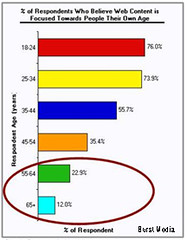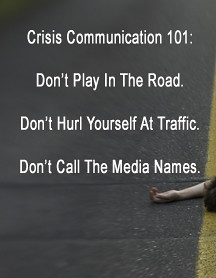A recent BurstMedia survey reveals that advertisers, especially those trying to reach audiences online, might be missing the boat. The survey alludes to the idea that the majority of Internet users ages 45+ believe online content is focused on younger age segments.
• Only about half of respondents, ages 35-44, believe Web sites are designed for them.
• Only 36.9 percent of respondents, ages 45-54, believe Web sites are designed for them.
• Only 19.9 percent of respondents, ages 55+, believe Web sites are designed for them.
Ya think? Advertising has been trending younger for some time now, online and off. Online it’s evident, mostly because of the mistaken notion that Internet users are all young. Sometimes its because designers are designing in a bubble, with little thought to their audience. Sometimes its because advertisers are skewing too much toward the medium with little or no thought of people.
The reality is that everybody is online; More than 80 percent in the U.S.
One of the most recent polls conducted by Harris Interactive last Nov. estimated that 97 percent of Americans with a computer is online (hat tip: Gary Gerdemann Peritus Public Relations).
In fact, when you compare the online population with the total population in the United States, the columns are proportionate, with the exception to those ages 65+. In addition, Internet usage has increased from seven hours per week in 2002 to more than 11 hours today.
While prevailing social media theory tends to ask companies to bend their message for technology, the BurstMedia survey is a reminder that tools do not dictate messages. Brand relationships exist between the company and the consumer. Technology is only a means of delivery or engagement.
Currently, 12 percent of the population is the 65+ group. By 2050, this age group will comprise 21 percent of the population, according to the U.S. Census Bureau.
In addition, this demographic will be well versed in online technologies and usage, requiring designers to consider content organization and ease of use much more readily than they do today. It makes sense.
Given the amount of demographic and psychographic information advertisers and marketers are pulling from the net, one would think they would apply it online ads. Or maybe not. We hear the same complaints about broadcast advertising and programming too.

• Only about half of respondents, ages 35-44, believe Web sites are designed for them.
• Only 36.9 percent of respondents, ages 45-54, believe Web sites are designed for them.
• Only 19.9 percent of respondents, ages 55+, believe Web sites are designed for them.
Ya think? Advertising has been trending younger for some time now, online and off. Online it’s evident, mostly because of the mistaken notion that Internet users are all young. Sometimes its because designers are designing in a bubble, with little thought to their audience. Sometimes its because advertisers are skewing too much toward the medium with little or no thought of people.
The reality is that everybody is online; More than 80 percent in the U.S.
One of the most recent polls conducted by Harris Interactive last Nov. estimated that 97 percent of Americans with a computer is online (hat tip: Gary Gerdemann Peritus Public Relations).
In fact, when you compare the online population with the total population in the United States, the columns are proportionate, with the exception to those ages 65+. In addition, Internet usage has increased from seven hours per week in 2002 to more than 11 hours today.
While prevailing social media theory tends to ask companies to bend their message for technology, the BurstMedia survey is a reminder that tools do not dictate messages. Brand relationships exist between the company and the consumer. Technology is only a means of delivery or engagement.
Currently, 12 percent of the population is the 65+ group. By 2050, this age group will comprise 21 percent of the population, according to the U.S. Census Bureau.
In addition, this demographic will be well versed in online technologies and usage, requiring designers to consider content organization and ease of use much more readily than they do today. It makes sense.
Given the amount of demographic and psychographic information advertisers and marketers are pulling from the net, one would think they would apply it online ads. Or maybe not. We hear the same complaints about broadcast advertising and programming too.






















